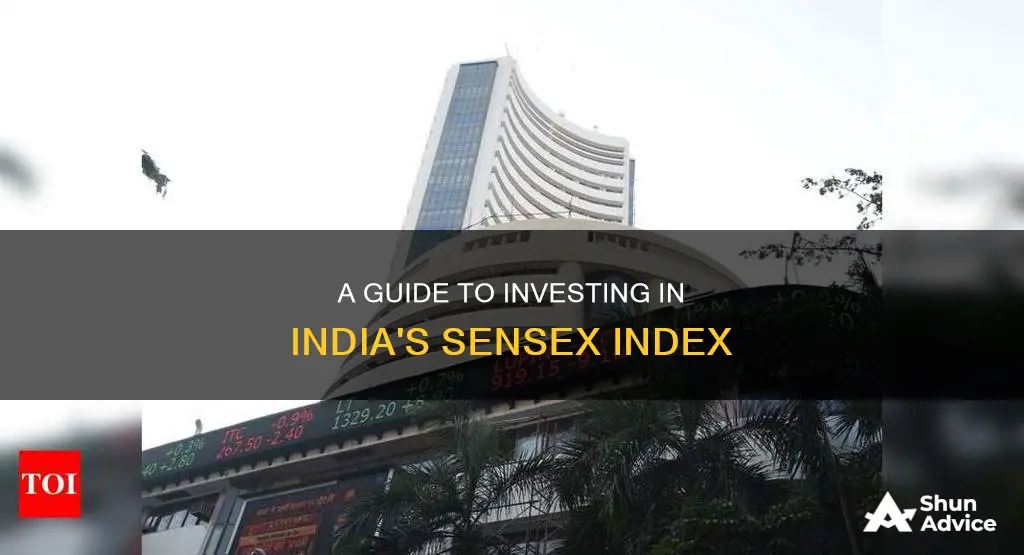
The Indian stock market is highly volatile, making it challenging for new investors to track individual stocks. This is where market indices like Sensex come in. Sensex, short for the Sensitive Index, is a benchmark stock index of the Bombay Stock Exchange (BSE) that comprises 30 of the most actively traded and highly capitalized stocks in India. It is calculated using a free-float market capitalization method, which considers only the shares available for trading by the general public. This index is crucial for investors as it helps them gauge market movements and make informed investment decisions. To invest in Sensex, one must open a Demat and trading account, have a bank account and PAN card, and then choose their preferred investment method, such as direct stock investment, exchange-traded funds (ETFs), or index mutual funds.
| Characteristics | Values |
|---|---|
| Name | Sensex |
| Full Form | Stock Exchange Sensitive Index |
| Type | Market Index |
| Number of Stocks | 30 |
| Companies | Tata Consultancy Services Ltd., Reliance Industries Ltd., Mahindra & Mahindra Ltd., Power Grid Corporation of India Ltd., HCL Technologies Ltd., Titan Company Limited, Ultratech Cement Ltd., Larsen & Toubro Ltd., Sun Pharmaceutical Industries Ltd., Maruti Suzuki India Ltd., Housing Development Finance Corp. Ltd., Hindustan Unilever Ltd., Oil & Natural Gas Corporation Ltd., Kotak Mahindra Bank Ltd., Axis Bank, Asian Paints, Bajaj Finance, Bharti Airtel, Coal India, IndusInd Bank, ICICI Bank, etc. |
| Calculation Method | Free-Float Capitalisation Method |
| Calculation Formula | Free Float Market Capitalization = Market Capitalization x Free Float Factor |
| Base Value | 100 or 1,000 |
| Investment Options | Direct Stock Investment, Exchange-Traded Funds (ETFs), Mutual Funds, Index Futures and Options |
| Prerequisites for Investment | Demat Account, Trading Account, Bank Account, PAN Card |
What You'll Learn

Open a Demat account
To invest in the Sensex, you need to open a Demat account. A Demat account is an account that holds your shares in electronic form. It is important to have a Demat account set up before you begin trading on the Sensex.
There are several online platforms that allow you to open a Demat account. These platforms usually have a simple sign-up process and may offer paperless onboarding. Some may also offer incentives such as no account opening charges for the first year. When choosing a platform, it is important to consider factors such as brokerage charges, order limits, and the level of dedicated support provided.
Once you have opened a Demat account, you will need to register for a trading account. This is because the Bombay Stock Exchange (BSE) does not allow for the direct purchase or sale of securities. With a trading account, you will be able to buy and sell securities online with ease.
It is important to note that, in addition to a Demat and trading account, you will also need a bank account and a PAN card to trade on the Sensex.
Car Savings: Invest or Keep?
You may want to see also

Open a Trading account
To start investing in the Indian stock market, you will need to open a trading account. This is because the Bombay Stock Exchange (BSE) does not allow the direct purchase or sale of securities.
To open a trading account, you must first register yourself with either a registered broker or a brokerage platform. Once you have done this, you will be able to buy and sell securities online.
It is important to note that to trade on Sensex, you will also need a Demat account, a bank account, and a PAN card.
Choosing the Right Financial Institution for Your Investment Portfolio
You may want to see also

Have a bank account and PAN card
To invest in the Sensex in India, you must have a bank account and a PAN card. These are essential requirements, along with a Demat and trading account, to trade on the Sensex. A Demat account is necessary to hold your shares in electronic form, and a trading account is needed to buy and sell securities online.
The process of opening a bank account in India may vary depending on the specific bank and your individual circumstances. However, there are some general steps and requirements that you should be aware of. Firstly, you will need to choose a bank and select the type of account you want to open, such as a savings or current account. Some popular banks in India include the State Bank of India, HDFC Bank, and ICICI Bank. When you have decided on a bank and account type, you can proceed to the next step, which is gathering the required documents. For Indian citizens, a PAN card, Aadhaar card, and proof of address are usually the essential documents needed to open a bank account. Some banks may also require additional documents, such as proof of identity and income. It is recommended to check with your chosen bank about their specific requirements. Once you have all the necessary documents, you can visit the bank branch to fill out the account opening form and submit the paperwork. In some cases, certain banks may offer the option of opening an account online through their website or mobile application. After submitting your application, the bank will verify your documents, and your account will be opened. You will typically receive your account number and other relevant information at this stage.
A PAN card, short for Permanent Account Number card, is a crucial identifier in India. It is a unique, 10-digit alphanumeric identifier issued by the Indian Income Tax Department. The PAN card serves as proof of identity and is mandatory for various financial transactions, including investing in the stock market. Obtaining a PAN card can be done through an online or offline application process. The application typically requires you to provide personal information, such as your name, date of birth, address, and proof of identity and address. The application fee for a PAN card is currently ₹110 for Indian citizens and ₹1020 for foreign citizens. After submitting your application, you will receive an acknowledgement number, which can be used to track the status of your application. The processing time for a PAN card can vary, but it usually takes around 15 working days. Once your application is approved, you will be able to download your e-PAN card from the official website or receive a physical copy by mail, depending on your chosen delivery preference.
Having a bank account and PAN card are fundamental requirements for investing in the Sensex. They provide you with the necessary tools to facilitate financial transactions and serve as proof of your identity. With these in place, you can proceed with the other steps involved in investing in the Sensex, such as choosing your investments and deciding on your investment strategy.
Knowledge Management: A Smart Investment for Future Success
You may want to see also

Choose your investments
Once your account is open, you can freely invest in the constituents of Sensex and the weightage that they have in that particular index. However, the better option to invest in Sensex is by investing in index mutual funds or Exchange-Traded Funds (ETFs).
Sensex consists of the top companies in India, and if you buy Sensex, you become a part-owner of these companies. There are two ways to invest in Sensex:
- Buy stocks directly – You can start investing directly in the constituents of the Sensex and the weightage they have in that particular index. This means that you can directly buy the stocks in the quantity that is equivalent to the stock's weightage. However, this option can be expensive as you cannot buy a fraction of stocks in India.
- Invest in index mutual funds – The better option is to invest in index mutual funds. These funds replicate the index, meaning they have a portfolio that exactly matches the index. So a Sensex index fund will have the 30 stocks in the same proportion as the Sensex. Index mutual funds are professionally managed, allowing you to invest a smaller amount of money. They are passively managed, keeping transaction costs low, and are a more straightforward way to access the stock market.
Investment Management: My Passion, My Career, My Future
You may want to see also

Consider investing in index mutual funds or ETFs
Index mutual funds and ETFs (Exchange-Traded Funds) are an excellent way to invest in the Sensex. Here are some reasons why you should consider these investment vehicles:
Diversification and Risk Mitigation:
Index funds provide investors with quick diversification by owning a basket of assets that replicate a market index like the Sensex. This lowers individual stock risk since the fund's performance is not dependent on a single company, resulting in a more stable and diversified portfolio. The wide range of stocks in index funds can also help mitigate risks during market downturns.
Low Expense Ratios:
Index funds and ETFs typically have lower expense ratios compared to actively managed funds. This makes them a cost-effective option, especially for long-term investors seeking broad market exposure while minimising expenses. The low expense ratio also translates to higher returns for investors.
Accessibility and Simplicity:
Index funds often have lower minimum investment requirements, making them accessible to a wider range of investors. They are also suitable for those who don't want to actively manage their investments or have limited knowledge of the stock market. The fund managers in index funds and ETFs make investment decisions based on the composition of the tracked index, removing the need for investors to continuously track the fund's performance.
Long-Term Investment Option:
Index funds are designed to replicate the performance of the Sensex or other market indices. This strategy often results in consistent and predictable returns, making index funds ideal for long-term investors seeking stable growth. Additionally, the risk of losing money in index funds is almost negligible over the long term.
Professional Management:
Index funds and ETFs are passively managed by fund managers who ensure that the fund's portfolio matches the tracked index. This means your investments are managed by professionals without the need for you to actively select individual stocks or time the market.
No Bias in Stock Selection:
In index funds and ETFs, the fund manager replicates the composition of the tracked index, eliminating any potential bias in stock selection. This automated approach ensures that your investments are based solely on the index's performance and removes any subjective decision-making by the fund manager.
Popular Index Funds and ETFs in India:
When considering index funds or ETFs in India, you can explore options such as the Nippon India Index BSE Sensex, HDFC Index Fund - BSE Sensex Plan, Tata BSE Sensex Index Fund, and ETFs like Nifty BeEs. Remember to research and compare the expense ratios, past returns, volatility, and underlying stocks and sectors before making your investment decision.
Understanding Standard Deviation for Investment Portfolio Risk
You may want to see also







